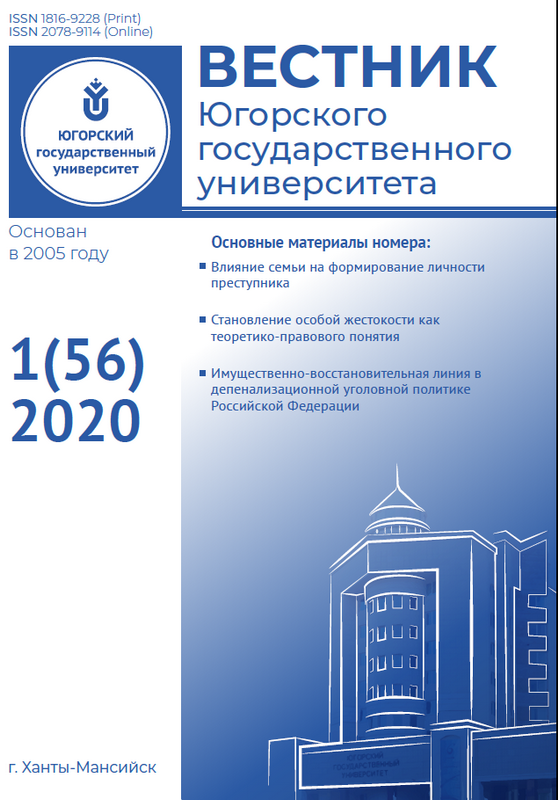Vol 16, No 1 (2020)
- Year: 2020
- Articles: 9
- URL: https://vestnikugrasu.org/byusu/issue/view/1978
Articles
INTERNATIONAL LEGAL, DOCTRINAL AND ORGANIZATIONAL-PRACTICALAPPROACHES TO COUNTERING MERCY-Violent Crimein the Russian Federation
Abstract
The subject of the study is mercenary-violent crime, taking into account its condition, structure and dynamics. Particular attention is paid to the implementation of the Russian criminal law policy in the field of combating crime of mercenary-violent orientation, taking into account the requirements of international law. The purpose of the study is a modern analysis of the understanding of mercenary-violent crime, the content and types of crimes of this orientation. Attention is focused on the criminological analysis of mercenary-violent crime, prevention and prevention in the context of improving measures of criminal law, criminological and organizational and practical counteraction. The methodological basis for the study of measures to combat mercenary-violent crime is formed by a set of general scientific and private scientific methods that have led to an integrated approach to the study of legal policy to counteract mercenary-violent crime, taking into account the ongoing socio-economic and political-legal transformations. The main results of the study reveal the process of counteracting mercenary-violent crime in the context of globalization, measures to increase the effectiveness of the implementation of the mechanism of criminal law regulation of public relations related to countering crimes of mercenary-violent orientation. Conclusions are formulated regarding the methodological and organizational-practical aspects of the legal impact on persons who have committed self-seeking and violent assaults. The novelty of the research topic is the formulation of the problem associated with the disclosure of the causes and conditions of mercenary-violent crime as a socially negative phenomenon in modern conditions; the definition of key areas of legal policy in the field of combating crimes of mercenary-violent orientation, determined by socio-economic and political transformations. In order to achieve the stated goal of the study, special legal methods of cognition were used that facilitate the analysis of the legal regulation of legal responsibility for mercenary-violent crimes. The result of the study is the disclosure of the legal nature of mercenary-violent crime, its essential properties and signs as a social negative phenomenon; identification of features of measures to counter self-serving and violent orientation; establishing trends in legal regulation of crimes of mercenary-violent orientation; determination of the specifics of the mechanism of legal regulation of legal liability for mercenary-violent crimes. An opinion was expressed that there was no categorical legal assessment of the concept of mercenary-violent crimes in domestic legislation, which predetermined the recognition of criminal legal measures as a strategic resource for combating mercenary-violent crime. The conclusions are formulated on the factors inspiring the legislative regulation of the corpus delicti of violent orientation, and the specifics of the implementation of punishment and other measures of a criminal law nature.
 7-16
7-16


PROPERTY-RESTORATION LINE IN DEPENALIZATION CRIMINAL POLICYOF THE RUSSIAN FEDERATION
Abstract
 17-22
17-22


THE SEIZURE OF NON-CASH FUNDS THROUGH THE USE OR THREAT OF VIOLENCE
Abstract
 25-29
25-29


INFLUENCE OF FAMILY ON FORMATION ON THE IDENTITY OF THE CRIMINAL
Abstract
 30-36
30-36


LEGAL CONTENT OF CATEGORY“PREPARATION FOR PERFORMANCE OF AN INTENTIONAL CRIME”
Abstract
 39-45
39-45


EVOLUTION OF PUNISHMENT IN RUSSIAN CRIMINAL LAW:PROBLEMS OF CONSISTENCY AND IMPROVEMENT
Abstract
 46-52
46-52


THE FORMATION OF SPECIAL RIGIDITYAS A THEORETICAL AND LEGAL CONCEPT
Abstract
 53-61
53-61


SYSTEM OF THE GENERAL PART OF THE CRIMINAL CODEOF THE RUSSIAN FEDERATION
Abstract
 62-70
62-70


PHONON SPECTRAL ENERGY DENSITY IN METALSWITH THE CUBIC LATTICE STRUCTURE
Abstract
 73-78
73-78











